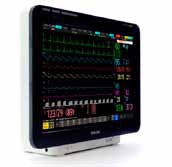How Philips maintains monitor price points


The latest version of the high-end product is the MX800 (right). It's sweet. It not only puts all your data on one screen, but integrates with a hospital's Electronic Medical Record (EMR) set-up and third-party programs providing clinical advice.
Chief medicalmarketing officer David Russell told ZDNet how the new product sets a new standard.
"Get away from the idea of a fixed box on the wall but integrate clinical informatics, applications that run independently and can access other systems. This combines everything in the informatics world at the point of care."
But not every hospital can afford a $35,000 monitor. None can afford to have them everywhere. So over the years Philips has built a broad product line, and when lower price points were needed it bought Goldway, China's second-leading medical monitor maker.
"The low-end spot check costs several thousand dollars and their multi-waveform costs $10-12,000. The IntelliVue has 8-10 models, from compact models that are very robust for the military to fixed ones in the ICU, with prices from $4-35,000."
Maintaining price points and margins against a backdrop of Moore's Law and hospital budgets is not easy, so I was tempted to ask Russell what comes next.
The answer I got was impressive. After integrating informatics with monitoring, Philips wants to extend that capability to every patient.
"Something like 12-17% of unanticipated deaths are happening where there is no monitoring.
"So we've launched the idea that you can hook patients up to very low cost devices, with wireless, run to a central location which can trend the data, and trigger when the patient starts to deteriorate, based on trends in vital signs.
"This early warning scoring system can be the key to call the emergency medical team.
"Our idea is to get monitoring into many areas of the hospital and keep patients from getting into the ICU, or prevent their deaths."
It's an impressive goal, which Philips is calling Guardian. New medical papers are giving insight into what is needed. "Respiration, heart rate, blood pressure -- you can put on one or a combination of them based on severity or price point."
What this means is that care can start as soon as a patient checks-in. Monitors will do the triage which health care workers don't have the time to do. No more dying in the waiting room.
It's ideas like that which earn Philips the big money.